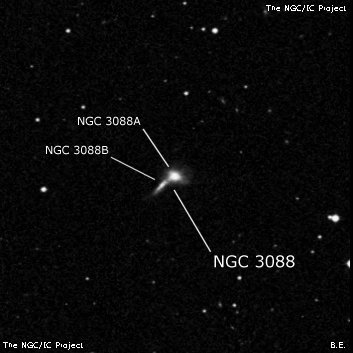
William Herschel discovered NGC 3088 = H III-24 = h661 on 12 Mar 1784 (sweep 166) and recorded "I suspect a vS nebula. [Higher power] rather confirmed it, but still left a doubt." His position is 8 sec of RA east of this double system. On 16 Feb 1860 from Birr Castle, Samuel Hunter wrote, "I think there are two wings, spp and sff." These probably refer to the two components.
The components have dimensions a) 0.9'x0.8' and b) 0.7'x0.2' and are listed separately as MCG +04-24-010 = NGC 3088a and MCG +04-24-011 = NGC 3088b.
400/500mm - 17.5" (4/9/94): fairly faint, very small, high surface brightness, possibly elongated ~E-W, either a stellar nucleus or a very faint star superimposed. A string of four collinear stars mag 11.5-13.3 is SW; the closest is a mag 12 star 4.8' WSW and the farther two forms a nice wide double (12.4/13.3 at 35"). There is an impression of faint haze off the SE end of galaxy which creates a sense of elongation. On the POSS, this is a double system – the "faint haze" off the SE end is actually an edge-on contact system MCG +04-24-010 = NGC 3088B.
600/800mm - 28" (4/12/18): at 285x; NGC 3088A, the main component of this overlapping pair, appeared moderately bright, small, roundish, fairly bright stellar nucleus, 25" diameter. NGC 3088B is attached to the southeast side. Most noticeable is a small, elongated nucleus, ~12"x6", that is centered 30" to the southeast of NGC 3088A. Occasionally very faint extensions were seen, increasing the size to 0.4'x0.1', merging with the halo of 3088A. A collinear string of four mag 11.5-13 stars is southwest and a mag 9.9 star lies 8' WNW.
UGC 3088 located 6.8' SW, appeared fairly faint, slightly elongated, 20" diameter, weak concentration. Occasionally fainter "wings" extending E-W were visible, increasing the dimensions to 35"x20". A wide pair of mag 12-13 stars is 2' W. The redshift z = .023 is similar to the components of NGC 3088.
Notes by Steve Gottlieb